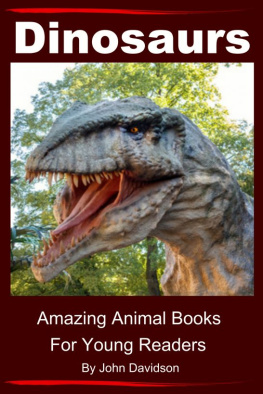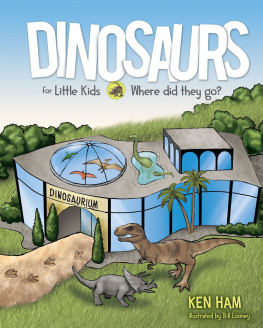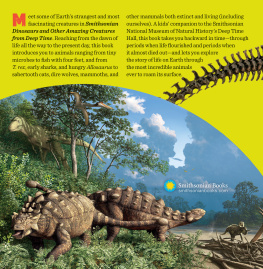Kay de Silva - Dinosaurs: Amazing Pictures & Fun Facts on Animals in Nature (Our Amazing World Series Book 8)
Here you can read online Kay de Silva - Dinosaurs: Amazing Pictures & Fun Facts on Animals in Nature (Our Amazing World Series Book 8) full text of the book (entire story) in english for free. Download pdf and epub, get meaning, cover and reviews about this ebook. year: 2013, publisher: CKTY Publishing Solutions, genre: Religion. Description of the work, (preface) as well as reviews are available. Best literature library LitArk.com created for fans of good reading and offers a wide selection of genres:
Romance novel
Science fiction
Adventure
Detective
Science
History
Home and family
Prose
Art
Politics
Computer
Non-fiction
Religion
Business
Children
Humor
Choose a favorite category and find really read worthwhile books. Enjoy immersion in the world of imagination, feel the emotions of the characters or learn something new for yourself, make an fascinating discovery.

- Book:Dinosaurs: Amazing Pictures & Fun Facts on Animals in Nature (Our Amazing World Series Book 8)
- Author:
- Publisher:CKTY Publishing Solutions
- Genre:
- Year:2013
- Rating:4 / 5
- Favourites:Add to favourites
- Your mark:
- 80
- 1
- 2
- 3
- 4
- 5
Dinosaurs: Amazing Pictures & Fun Facts on Animals in Nature (Our Amazing World Series Book 8): summary, description and annotation
We offer to read an annotation, description, summary or preface (depends on what the author of the book "Dinosaurs: Amazing Pictures & Fun Facts on Animals in Nature (Our Amazing World Series Book 8)" wrote himself). If you haven't found the necessary information about the book — write in the comments, we will try to find it.
Kay de Silva: author's other books
Who wrote Dinosaurs: Amazing Pictures & Fun Facts on Animals in Nature (Our Amazing World Series Book 8)? Find out the surname, the name of the author of the book and a list of all author's works by series.
Dinosaurs: Amazing Pictures & Fun Facts on Animals in Nature (Our Amazing World Series Book 8) — read online for free the complete book (whole text) full work
Below is the text of the book, divided by pages. System saving the place of the last page read, allows you to conveniently read the book "Dinosaurs: Amazing Pictures & Fun Facts on Animals in Nature (Our Amazing World Series Book 8)" online for free, without having to search again every time where you left off. Put a bookmark, and you can go to the page where you finished reading at any time.
Font size:
Interval:
Bookmark:
DINOSAURS
Amazing Pictures & Fun Facts on Animals in Nature
Our Amazing World Series
Kay de Silva
Copyright Notice
Dinosaurs - Our Amazing World Series
Copyright 2013 by Kay de Silva - All rights reserved
Please respect the author's copyright of this work. You may use this e-book for your personal enjoyment. Like a printed book you may share it with family and friends. In so doing please do not change the format or modify the content in any way. In addition, your license to enjoy this work does not extend to re-selling, using or re-distributing this work wholly or partially for any other commercial endeavour. In all other respects, as a licensed owner of this e-book you are invited to enjoy and benefit from this work. Please support the author, by spreading the word about this work to those who could benefit by it and encouraging them to obtain a personal license to enjoy the book.
Image Credits: Royalty Free images reproduced under licence from various stock image repositories. Images produced under a creative commons licences are duly attributed.
Books in the Our Amazing World Series
Marine Life Four-Pack
Dinosaurs
Tigers
Sharks
Snakes
Spiders
Bears
Horses
Dolphins
Sea Turtles
Whales
Penguins
Marsupials
Dinosaurs

Dinosaurs roamed the earth for a period of 180 million years. This was during the Mesozoic Era, which was also known as the Age of Reptiles. Dinosaurs were one of many prehistoric animals that lived at the time. The word dinosaur means scary lizard.
Fossils

Dinosaurs were around long before people. So how do we know what dinosaurs looked like and how they lived? Fossils give us clues. Fossils are the preserved remains of plants and animals and their activities.
There are two types of fossils. The first is body fossils, which are the preserved remains of a plant or animal. The second is trace fossils, which are the remains of the activities of animals. These include footprints, track marks, fossilized egg shells, and nests.
Paleontologists study fossils to learn about the prehistoric world. This study is known as paleontology. Like detectives, paleontologists use all the clues they have to recreate what dinosaurs looked like and understand how they behaved millions of years ago.
Anatomy

Dinosaurs were neither reptiles nor birds. They were, however, closely related to both. It is said that the dinosaurs evolved from cold-blooded reptiles to warm-blooded animals, like the birds of today.
Dinosaurs also had a unique hip structure that allowed them to walk upright. The first dinosaurs walked on two legs (bipedal). Later some dinosaurs began to walk on all fours (quadrupedal). Even then, generally their front legs remained shorter than their back legs.
There are many types of dinosaurs, but the two main types are Sauropods and Theropods. Sauropods had four legs, and Theropods had two.
Habitat

All dinosaurs did not live at the same time, nor did they live in the same place. During different periods dinosaurs lived in different parts and habitats around the world.
Dinosaurs lived during three main periods in the Mesozoic Era: Triassic, Jurassic , and Cretaceous.
The Triassic Period was the first period, which was 250 to 200 million years ago. At the time it is believed that the world was joined together as a single super-continent called Pangaea. This continent was so huge that the inland areas were far away from the ocean. This created vast deserts in the middle of the continent. During this period dinosaurs lived near riversides and scrublands.
200 to 145 million years ago, during the Jurassic Period, Pangaea began to break up. This was believed to have been caused by volcanic eruptions. Shallow seas emerged and spread across former deserts. This resulted in damper climates and more vegetation being created. During this time dinosaurs primary habitats were forests.
During the Cretaceous Period, 145 to 65 million years ago, the continents had broken apart further. They began to look like the continents of today. The different land areas created different climates. Groups of dinosaurs that looked different from each other emerged across different continents. At this time dinosaurs lived in swamplands, mixed forests, mountains, and desert plains.
Senses

Understanding how a dinosaurs senses worked is difficult. This is because the parts that make up its brains have not fossilized well.
It is said that the Hadrosaurus (had-ro-SAWR-us) or the duckbilled dinosaur made lots of sounds and had a good sense of hearing. To make a noise it used a flap of skin over its broad beak, just like the throat-pouch of a bullfrog does.
The Parasaurolophus (PARR-uh-SAWR-uh-LOH-fus) had a crest that was made up of tubes connected to its nostrils. Blowing air through these tubes would have made a noise, which would have sounded much like a trombone.
The Troodon (TRUE-oh-don) was a turkey-sized carnivore with binocular vision. It had eyes that pointed forward and a brain as large as an emu's. This gave it the brain power to see three-dimensional images that it received using its binocular vision.
A Sauropod such as the Triceratops (try-SER-uh-tops) had eyes on the side of its head. This gave it a wide field of vision, which allowed it to quickly scan the landscape for danger and defend itself in time.
Movement

Dinosaurs usually walked on their toes (digitigrade). Digitigrade animals of today include cats, dogs, and chickens. Pads on the back of these animals feet act as shock absorbers . Humans, bears, and crocodiles, on the other hand, walk flat-footed (plantigrade).
Depending on their anatomy, some dinosaurs moved on all fours and others on two legs. A third type ran on two legs and grazed on four legs. Some were swift, while others were slow. A few bird-like dinosaurs may have used their feathered arms to speed up their running and possibly glide from trees to the ground.
Paleontologists used footprints to understand the movements of dinosaurs. Using these prints they were able to tell the structure of the animals feet, the number of toes dinosaurs had, whether there were pads on their feet, and whether they were plantigrade or not.
They were also able to tell how many legs dinosaurs had. Using the distance between prints and the length of the dinosaurs legs, they were able to work out how fast the animals moved.
Feeding

Sauropods were herbivores (plant eaters). They were usually slow-moving. They had four columnar legs and a long neck for grazing. They had long tails to counter-balance their long neck. These creatures had tiny heads and small brains.
Font size:
Interval:
Bookmark:
Similar books «Dinosaurs: Amazing Pictures & Fun Facts on Animals in Nature (Our Amazing World Series Book 8)»
Look at similar books to Dinosaurs: Amazing Pictures & Fun Facts on Animals in Nature (Our Amazing World Series Book 8). We have selected literature similar in name and meaning in the hope of providing readers with more options to find new, interesting, not yet read works.
Discussion, reviews of the book Dinosaurs: Amazing Pictures & Fun Facts on Animals in Nature (Our Amazing World Series Book 8) and just readers' own opinions. Leave your comments, write what you think about the work, its meaning or the main characters. Specify what exactly you liked and what you didn't like, and why you think so.



